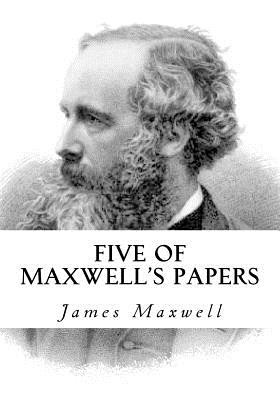
- We will send in 10–14 business days.
- Author: James Clerk Maxwell
- Publisher: CreateSpace Independent Publishing Platform
- ISBN-10: 1534820213
- ISBN-13: 9781534820210
- Format: 17.8 x 25.4 x 0.2 cm, minkšti viršeliai
- Language: English
- SAVE -10% with code: EXTRA
Reviews
Description
Five of Maxwell's Papers
James Clerk Maxwell
James Clerk Maxwell FRS FRSE (13 June 1831 - 5 November 1879) was a Scottish scientist in the field of mathematical physics. His most notable achievement was to formulate the classical theory of electromagnetic radiation, bringing together for the first time electricity, magnetism, and light as manifestations of the same phenomenon. Maxwell's equations for electromagnetism have been called the "second great unification in physics" after the first one realised by Isaac Newton.
With the publication of A Dynamical Theory of the Electromagnetic Field in 1865, Maxwell demonstrated that electric and magnetic fields travel through space as waves moving at the speed of light. Maxwell proposed that light is an undulation in the same medium that is the cause of electric and magnetic phenomena. The unification of light and electrical phenomena led to the prediction of the existence of radio waves.
Maxwell helped develop the Maxwell-Boltzmann distribution, a statistical means of describing aspects of the kinetic theory of gases. He is also known for presenting the first durable colour photograph in 1861 and for his foundational work on analysing the rigidity of rod-and-joint frameworks (trusses) like those in many bridges.
Table of Contents
- On the Unequal Sensibility of the Foramen Centrale to Light of different Colours
- On the Theory of Compound Colours with reference to Mixtures of Blue and Yellow Light
- On an Instrument to illustrate Poinsot's Theory of Rotation
- Address to the Mathematical and Physical Sections of the British Association
- Introductory Lecture on Experimental Physics
- Author: James Clerk Maxwell
- Publisher: CreateSpace Independent Publishing Platform
- ISBN-10: 1534820213
- ISBN-13: 9781534820210
- Format: 17.8 x 25.4 x 0.2 cm, minkšti viršeliai
- Language: English English
Five of Maxwell's Papers
James Clerk Maxwell
James Clerk Maxwell FRS FRSE (13 June 1831 - 5 November 1879) was a Scottish scientist in the field of mathematical physics. His most notable achievement was to formulate the classical theory of electromagnetic radiation, bringing together for the first time electricity, magnetism, and light as manifestations of the same phenomenon. Maxwell's equations for electromagnetism have been called the "second great unification in physics" after the first one realised by Isaac Newton.
With the publication of A Dynamical Theory of the Electromagnetic Field in 1865, Maxwell demonstrated that electric and magnetic fields travel through space as waves moving at the speed of light. Maxwell proposed that light is an undulation in the same medium that is the cause of electric and magnetic phenomena. The unification of light and electrical phenomena led to the prediction of the existence of radio waves.
Maxwell helped develop the Maxwell-Boltzmann distribution, a statistical means of describing aspects of the kinetic theory of gases. He is also known for presenting the first durable colour photograph in 1861 and for his foundational work on analysing the rigidity of rod-and-joint frameworks (trusses) like those in many bridges.
Table of Contents
- On the Unequal Sensibility of the Foramen Centrale to Light of different Colours
- On the Theory of Compound Colours with reference to Mixtures of Blue and Yellow Light
- On an Instrument to illustrate Poinsot's Theory of Rotation
- Address to the Mathematical and Physical Sections of the British Association
- Introductory Lecture on Experimental Physics


Reviews